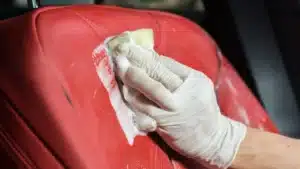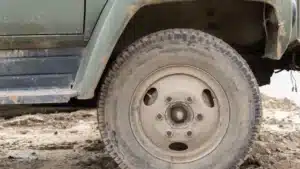It doesn’t take a car buff to know when your vehicle’s clear coat is starting to come apart. When the clear coat deteriorates enough because of oxidation or UV damage, it can fall off, bubble, and peel, which can cause a chain reaction.
If you notice the clear coat starting to peel off over areas of your car, it’s important to act fast to limit the damage and protect the car’s paint from damage.
Fortunately, you don’t need a complete repaint job if the clear coat is coming apart. This article will discuss a few different methods for removing the clear coat without negatively affecting the undercoat. Read more about how to fix clear coat peeling

What is Clear Coat?
First, let’s briefly discuss the different layers of the car paint process and the role the clear coat plays in all of it. There are three stages in the car painting process.
- Primer. The primer helps the base coat adhere better to the car’s body.
- Base coat. The base coat is the actual colored paint that goes on the car’s body. The three most common types of base coats include solid, metallic, and pearlescent.
- Clear coat. The clear coat is a transparent, glossy coat that gives the car’s paint its shine. It also serves as the protective layer for the base coat, protecting it from harmful UV rays and stones, and other debris that can hit up against the car.
Some Warnings to Know About Before Removing Clear Coat from A Car
It’s important to note that removing clear coat from an entire vehicle is a laborious process that requires a certain level of skill and expertise. It also requires specific tools that not everyone owns. Bottom line: it’s not for everyone.
If you’re not familiar with the ins and outs of car maintenance, it’s probably better to leave this task to a professional. The cost of repairing the potential damage that can occur by removing clear coat with a DIY method will offset the savings of doing it yourself anyway.
You’ll pay more money to hire a professional to remove the clear coat, but you’ll guarantee the job gets done right.
It’s also important to note that you should never use paint thinner to remove the clear coat from your car. Although it may seem like it could work, it would take several applications to remove the coat, and it’s highly likely that you could damage the underlying paint in the process, costing you hundreds of extra dollars.
Equipment and Tools Necessary for The Process
If you decide that you’re up for the challenge of removing your car’s clear coat, you’ll need to make sure you have all of the necessary equipment and tools on hand.
The items you’ll need to get started include:
- Soft brush
- A hose
- Soft sponge
- Soap
- Dry and soft cloth
- 400-, 800-, 1,000-, and 1,200-grit sandpaper
- Tape
- Polisher
- Electric polisher
- Buffing pads
- Spray detailer
- Clean cloth
How to Remove Peeling Clear Coat from A Car (Step By Step)
Phew, that’s a long list of items that are needed to remove the clear coat from your car, but it will all be worth it in a few hours once you’ve properly removed all of it.
Here are the steps to properly remove the clear coat:
Thoroughly clean the car
While you may be tempted to jump right into removing the clear coat, you should never skip the important first step of completely cleaning the car of any dirt, dust, or grime. We recommend first using a soft brush to remove any dirt and debris from the car’s clear coat.
Once you’ve done a thorough job, soak the entire vehicle with a garden hose. Then, use a sponge to wash the car with soap and warm water.
When you’re finished cleaning the car, use a dry and soft cloth to completely dry the car, removing any excess moisture in the process. Before moving on to the next step, let the car completely dry off.
Soak the sandpaper
While you’re cleaning the car, soak the 400-grit sandpaper in the sink, a bowl, or a container. This may seem like a strange task to some, but the water helps strengthen the sandpaper.
Wet sand the clear coat
The wet-sanding portion of removing the clear coat involves two parts: using the 400-grit sandpaper and then gradually introducing the 800-, 1,000-, and 1,200-grit sandpapers.
Now that the 400-grit sandpaper is wet, use it to gently rub it atop the clear coat of your car to weaken the clear coat and even out scratches.
Next, it’s time to move on to finer-grain sandpaper. Gradually introduce the 800-, 1,000-, and 1,200-grit sandpapers. With each upgrade in sandpaper grit, you’ll remove more and more of the clear coat. Just be careful not to sand too hard so you don’t damage the interior paint.
Additional prep work
Once you’re finished with the two stages of wet sanding your vehicle’s clear coat, prep the delicate parts of your car before you begin the dry sanding portion.
Tape the delicate portions of your car to protect them from being damaged during the next step. Some examples of delicate areas include tail lights, mirrors, windows, screen wipers, and rims.
Dry sanding
Ensure your car is completely dry before you begin the dry-sanding process. Dry sanding can be done with either 600- or 800-grit sandpaper.
Since most of the clear coat will be removed during the wet-sanding process, it’s important to be delicate with this step so you don’t damage the paint. Focus on even, smooth finishes while dry sanding the clear coat. When focusing on scratches, consider sanding at a 45-degree angle and go with the natural grains.
Rinse and dry the car
Once you’re finished dry sanding the clear coat, use a hose to completely wash the car off to remove particles and grit caused by sanding. During this step, pay attention to see if the water turns milky. If it does, this is an indication that you’ve sanded enough, and any additional sanding could damage the undercoat.
Polish and buff the sanded area
If the surface of the vehicle is now smooth and even, you can move on to the next step of polishing and buffing the sanded area. If you’ve made it to this step, you’re nearly done!
It’s now time to get out your electric polisher. Apply a polisher evenly over the entire surface of the clear coat, and set the polisher to the motion setting at a rotation speed of 1,200 to 1,400 revolutions per minute.
Work in a circular motion to ensure every area of the surface is polished and buffed. If you don’t have an electric polisher, use a 100% wool cloth and buff by hand.
Clean the polished area
Finally, apply a spray detailer to the vehicle and use the electric polisher to give the surface a clean and extra glossy finish. This final step will also eliminate any of the remaining particles on the car.
How to Remove Clear Coat Without Sanding
Although you may be able to find other methods online for removing clear coat such as paint thinner, we highly recommend using the sandpaper method. This is a proven way of removing clear coat while reducing the risk of damaging your car’s interior paint job.
FAQ
What grit sandpaper to remove clear coat from car?
There are several different brands of grit sandpaper available at your local hardware store. Just be sure to buy 400-, 800-, 1,000-, and 1,200 grit sandpaper.
Will acetone remove clear coat on car?
Acetone is a viable option when removing paint that was spilled on your car’s surface. But it’s not recommended to use acetone to remove clear coat as it can eat right through the clear coat and damage the car paint underneath.
Can you spray clear coat over clear coat?
It’s only recommended to spray clear coat if the existing clear coat is in good condition. If the existing clear coat is warped or peeling, you’ll need to remove it first.
What happens if you paint over clear coat?
Before you apply a new layer of paint to your vehicle, you’ll need to remove the existing clear coat.
How much does it cost to respray clear coat?
Respraying clear coat can be pricey and may cost you as much as $3,000.
How long until you can sand clear coat?
You can sand the clear coat when you notice signs that it’s deteriorating or beginning to peel.
Why is the clear coat peeling off my car?
One of the most common reasons your clear coat is peeling off is because of damage caused by extended exposure to harmful UV rays.
Can you wax a car with no clear coat?
It’s not a good idea to wax a car with no clear coat because some of the car’s paint could come off in the process.
Related Content:



